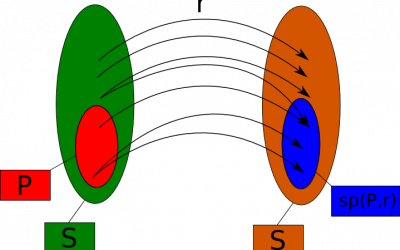Hoare Logic Basics
Hoare logic is a way of inserting annotations into code to make proofs about program behavior simpler. We first explain them using sets and relations.
Example Proof
//{0 <= y} i = y; //{0 <= y & i = y} r = 0; //{0 <= y & i = y & r = 0} while //{r = (y-i)*x & 0 <= i} (i > 0) ( //{r = (y-i)*x & 0 < i} r = r + x; //{r = (y-i+1)*x & 0 < i} i = i - 1 //{r = (y-i)*x & 0 <= i} ) //{r = x * y}
Hoare Triple for Sets and Relations
When  (sets of states) and
(sets of states) and  (relation on states, command semantics) then
Hoare triple
(relation on states, command semantics) then
Hoare triple

means

We call  precondition and
precondition and  postcondition.
postcondition.
Note: weakest conditions (predicates) correspond to largest sets; strongest conditions (predicates) correspond to smallest sets that satisfy a given property (Graphically, a stronger condition  denotes one quadrant in plane, whereas a weaker condition
denotes one quadrant in plane, whereas a weaker condition  denotes the entire half-plane.)
denotes the entire half-plane.)
Strongest Postcondition - sp
Lemma: Characterization of sp
 is the the smallest set
is the the smallest set  such that
such that  , that is:
, that is:
Backward Propagation of Errors
If we have a relation  and a set of errors
and a set of errors  , we can check if program meets specification by checking:
, we can check if program meets specification by checking:









In other words, we obtain an upper bound on the set of states  from which we do not reach error. We next introduce the notion of weakest precondition, which allows us to express
from which we do not reach error. We next introduce the notion of weakest precondition, which allows us to express  from
from  given as complement of error states
given as complement of error states  .
.
Weakest Precondition - wp
Definition: for  ,
,  ,
,

Note that this is in general not the same as  when then relation is non-deterministic or partial.
when then relation is non-deterministic or partial.
Lemma: Characterization of wp
 is the largest set
is the largest set  such that
such that  , that is:
, that is:
Some More Laws on Preconditions and Postconditions
We next list several more lemmas on properties of wp, sp, and Hoare triples.
Postcondition of inverse versus wp
If instead of good states we look at the completement set of “error states”, then  corresponds to doing
corresponds to doing  backwards. In other words, we have the following:
backwards. In other words, we have the following:

Disjunctivity of sp


Conjunctivity of wp


Pointwise wp

Pointwise sp

Three Forms of Hoare Triple
The following three conditions are equivalent:
Expanding Paths
The condition

is equivalent to

Transitivity
If  and
and  then also
then also  .
.
We write this as the following inference rule:

Hoare Logic for Loops
The following inference rule holds:

Proof is by transitivity.
By Expanding Paths condition above, we then have:

In fact,  , so we have
, so we have

This is the rule for non-deterministic loops.
 ,
, 








